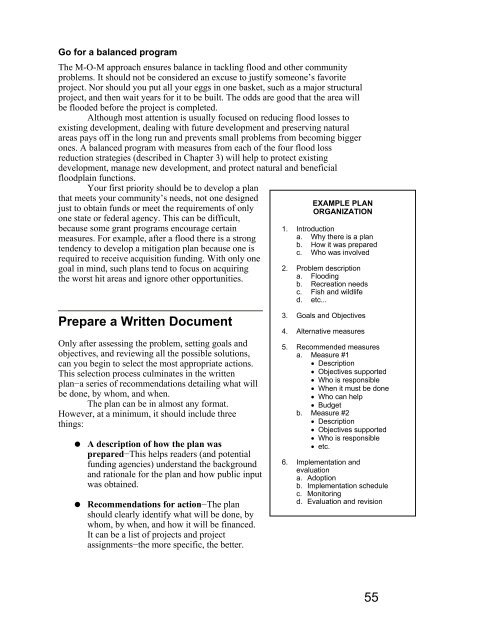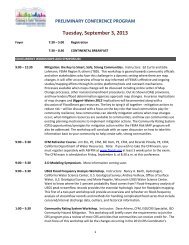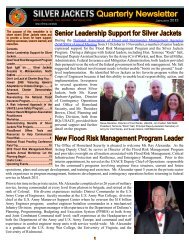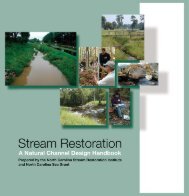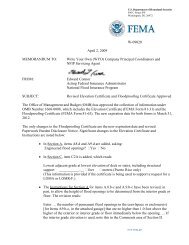Using Multi-Objective Management to Reduce Flood Losses in Your
Using Multi-Objective Management to Reduce Flood Losses in Your
Using Multi-Objective Management to Reduce Flood Losses in Your
Create successful ePaper yourself
Turn your PDF publications into a flip-book with our unique Google optimized e-Paper software.
Go for a balanced program<br />
The M-O-M approach ensures balance <strong>in</strong> tackl<strong>in</strong>g flood and other community<br />
problems. It should not be considered an excuse <strong>to</strong> justify someone’s favorite<br />
project. Nor should you put all your eggs <strong>in</strong> one basket, such as a major structural<br />
project, and then wait years for it <strong>to</strong> be built. The odds are good that the area will<br />
be flooded before the project is completed.<br />
Although most attention is usually focused on reduc<strong>in</strong>g flood losses <strong>to</strong><br />
exist<strong>in</strong>g development, deal<strong>in</strong>g with future development and preserv<strong>in</strong>g natural<br />
areas pays off <strong>in</strong> the long run and prevents small problems from becom<strong>in</strong>g bigger<br />
ones. A balanced program with measures from each of the four flood loss<br />
reduction strategies (described <strong>in</strong> Chapter 3) will help <strong>to</strong> protect exist<strong>in</strong>g<br />
development, manage new development, and protect natural and beneficial<br />
floodpla<strong>in</strong> functions.<br />
<strong>Your</strong> first priority should be <strong>to</strong> develop a plan<br />
that meets your community’s needs, not one designed<br />
just <strong>to</strong> obta<strong>in</strong> funds or meet the requirements of only<br />
one state or federal agency. This can be difficult,<br />
because some grant programs encourage certa<strong>in</strong><br />
measures. For example, after a flood there is a strong<br />
tendency <strong>to</strong> develop a mitigation plan because one is<br />
required <strong>to</strong> receive acquisition fund<strong>in</strong>g. With only one<br />
goal <strong>in</strong> m<strong>in</strong>d, such plans tend <strong>to</strong> focus on acquir<strong>in</strong>g<br />
the worst hit areas and ignore other opportunities.<br />
EXAMPLE PLAN<br />
ORGANIZATION<br />
1. Introduction<br />
a. Why there is a plan<br />
b. How it was prepared<br />
c. Who was <strong>in</strong>volved<br />
2. Problem description<br />
a. <strong>Flood</strong><strong>in</strong>g<br />
b. Recreation needs<br />
c. Fish and wildlife<br />
d. etc...<br />
Prepare a Written Document<br />
Only after assess<strong>in</strong>g the problem, sett<strong>in</strong>g goals and<br />
objectives, and review<strong>in</strong>g all the possible solutions,<br />
can you beg<strong>in</strong> <strong>to</strong> select the most appropriate actions.<br />
This selection process culm<strong>in</strong>ates <strong>in</strong> the written<br />
plan−a series of recommendations detail<strong>in</strong>g what will<br />
be done, by whom, and when.<br />
The plan can be <strong>in</strong> almost any format.<br />
However, at a m<strong>in</strong>imum, it should <strong>in</strong>clude three<br />
th<strong>in</strong>gs:<br />
A description of how the plan was<br />
prepared−This helps readers (and potential<br />
fund<strong>in</strong>g agencies) understand the background<br />
and rationale for the plan and how public <strong>in</strong>put<br />
was obta<strong>in</strong>ed.<br />
Recommendations for action−The plan<br />
should clearly identify what will be done, by<br />
whom, by when, and how it will be f<strong>in</strong>anced.<br />
It can be a list of projects and project<br />
assignments−the more specific, the better.<br />
3. Goals and <strong>Objective</strong>s<br />
4. Alternative measures<br />
5. Recommended measures<br />
a. Measure #1<br />
• Description<br />
• <strong>Objective</strong>s supported<br />
• Who is responsible<br />
• When it must be done<br />
• Who can help<br />
• Budget<br />
b. Measure #2<br />
• Description<br />
• <strong>Objective</strong>s supported<br />
• Who is responsible<br />
• etc.<br />
6. Implementation and<br />
evaluation<br />
a. Adoption<br />
b. Implementation schedule<br />
c. Moni<strong>to</strong>r<strong>in</strong>g<br />
d. Evaluation and revision<br />
55


